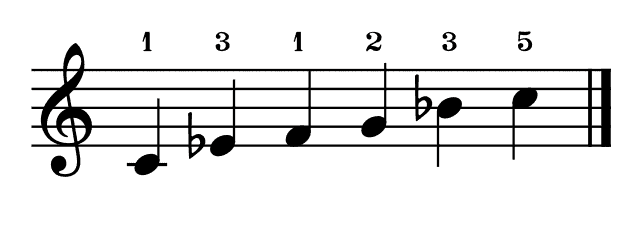Learning the blues is an integral part of modern music making. The power and influence of the style can be felt in most forms of contemporary popular music and the music carries historical lessons and legacies that are vitally important. Particular scales have emerged out of the music called the blues scales. You might be asking yourself what is a blues scale, because understanding this is an important access point to playing the music on the piano!
Key Takeaways
- There are differences between major and minor blues scales
- Pentatonic scales only have five notes, while blues scales have six
- Chords in a blues form are almost always the same in every key
- The formula for the blues scales are different for major or minor
- Fingerings for the pentatonic scales and the blues scales are different

What is the blues scale?
Firstly, there is not just one ‘blues scale’, there are two: a major and a minor variation. Odds are when someone says to you “play a blues scale”, what they mean is play the minor version, so it will come first here.
Blues scales are very common in music. They are found all over the world, in music on the radio and classical music. The important thing to remember is that both of these major and minor variations are based off of pentatonic scales, with a flat 5th added, making each scale have six notes total.
| C Major Blues: | C D Eb E G A |
| C Minor Blues: | C Eb F F# G Bb |
How to play the minor blues scale
The minor blues scale piano is a six note scale that has emerged from Blues music. It has a powerful, soulful, and often melancholic timbre. It is used across many styles of music including traditional twelve-bar Blues, Boogie-Woogie, Soul, RnB, Jazz, and Funk to name a few. This scale is a variation on the minor pentatonic scale with an added flat fifth scale degree.
Minor pentatonic scales explained
The minor pentatonic scale is a five note scale. It is a common piano scale that is found in many music cultures across the world. If you randomly ask someone on the street to sing a five note scale, chances are they will sing the minor pentatonic scale.
Seriously, try it! It is somehow ingrained in the human subconscious, especially the first minor third interval.
The minor pentatonic scale follows the scale degree formula 1 – ♭3 – 4 – 5 – ♭7. To play the minor pentatonic scale from C on the piano, follow the diagram below. The finger numbers for the minor pentatonic scale are notated beneath the notes.

To transform the minor pentatonic scale into the minor blues scale, all you need to do is add in the flat fifth scale degree to the minor pentatonic scale. In the key of C minor pentatonic, that means you will add the note G♭. Check out the diagram below to see this new scale notated.
Learning the minor blues scale formula
The formula for this new minor blues scale is 1 – ♭3 – 4 – ♭5 – ♮5 – ♭7.
In vocal styles, the pitch of the flat fifth scale degree is bent up and down for added inflection, expressive power, and emotional impact. However, in tempered pitched instruments with unbending intonation, the flat fifth scale degree cannot be manipulated in the same way.
We also call this flat fifth scale degree the blue note. Adding the blue note to the minor is your gateway to the blues.
Playing the minor blues scale in multiple positions
Can you use the formula and finger pattern you just learned to move the minor blues scale around the piano? Try to use your knowledge to build the scale from D, F, G, and A. Remember, the formula is 1 – ♭3 – 4 – ♭5 – ♮5 – ♭7, or the minor pentatonic scale with an added flat fifth scale degree.
- From D, the scale is spelled D – F – G – G# – A♮ – C. The blue note in this minor scale is A flat. Check out the diagram below to see it notated:

- From F, the scale is spelled F – A♭ – B♭ – B – C♮ – E♭. The blue note in this minor scale is C flat Check out the diagram below to see it notated:
 Notice the change in finger pattern here. Instead of your first finger on the third note, you continue with your fourth finger and land with your first finger on C♭. Practice this different finger pattern until you feel comfortable.Remember, practicing with proper piano technique and fingering means greater technique, control, and creativity down the road!
Notice the change in finger pattern here. Instead of your first finger on the third note, you continue with your fourth finger and land with your first finger on C♭. Practice this different finger pattern until you feel comfortable.Remember, practicing with proper piano technique and fingering means greater technique, control, and creativity down the road!
- From G, the minor blues scale is spelled G – B♭ – C – C# – D – F. The blue note in this minor scale is D flat. Check out the diagram below for the finger pattern:
 The finger pattern for G minor blues scale is the same as it was for C and D. This is a common finger pattern for the minor blues scale and you will see it again!
The finger pattern for G minor blues scale is the same as it was for C and D. This is a common finger pattern for the minor blues scale and you will see it again! - From A, the A minor blues scale is spelled A – C – D – E♭ – E♮ – G. The blue note in this minor scale is E flat. Check out the diagram below for the finger pattern, you will find it familiar:

Ok! Now that you have played through five different positions of the minor blues scales (C, D, F, G, A), you are ready for some exercise!
First, play through all five patterns in a row, beginning with C, followed by D, F, G, then A and returning to C again one octave higher.
How to play the major blues scale
The major blues scale is a variation on the scale with a major sounding quality as opposed to a minor sounding quality. It is based off of the major pentatonic scale, just like our minor scale was based off of the minor pentatonic scale. We also have just one note to change, and then we’re off to play!
Major pentatonic scales explained
The major blues scale is a variation on the major pentatonic scale. It shares the same addition of the flat fifth scale degree.
The scale degree formula for the major pentatonic scale is 1 – 2 – 3 – 5 – 6. In the key of C major, this is spelled C – D – E – G – A. Check out this notation below:
Learning the major blues scale formula
All we need to do to transform this C major scale into the C major blues scale is add the flat 3rd scale degree.
This means the new formula for the major blues scale will be 1 – 2 – b3 – 3 – 5 – 6. In the key of C, we spell this C – D – Eb – E – G – A. The blue note in this major scale is E flat.
Try substituting the major blues scale for all the exercises you practiced above. Pay attention to how the major blues scale sounds compared to the minor blues scales. Also make sure to note how the blue notes differ between the major scale and minor scale.
Playing the major blues scale in multiple positions
Because we know that all of our major blues scales are being pulled from the major pentatonic scale, and we know that they all have the same formula, we can learn a lot of them very quickly! Remember to think about the music in scale degrees, 1 – b3 – 3 – 5 – 6. Let’s try it in a bunch of different positions!
- From D, the scale is spelled: D, E, F, F#, A, B, D

- From F, the scale is spelled: F, G, Ab, A, C, D, F

- From G, the scale is spelled: G, A, Bb, B, D, E, G

- From A, the scale is spelled: A, B, C, C#, E, F#, A

Exercising the blues scales
You can incorporate some exercises into your practice such as sequences. Practice playing your piano chords. Check out a three note sequence in the C minor blues scale below:

This sequence pattern is a great exercise to practice to gain dexterity and flexibility with the minor blues scale. You can apply this pattern to any other scales like the piano chromatic scale you are practicing!
Get comfortable playing through the blues form in quarter notes. Practicing this will build your fluidity with these shapes and help develop your ears. There are a few points of tension and release that you should become comfortable with.
The first is the transition in and out of the IV chord in measures 5-7 and the second is the turnaround, the V-IV-I progression in measures 9-12. These points act as springboards in the form.
You can use these points to build up tension in your improvisation or as release or resolution points.
Once you feel comfortable with the form in C, modulate the progression to D, F, G, and A.
- In the key of D, the I, IV, and V chords are D, G, and A.
- In the key of F, the I, IV, and V chords are F, B♭, and C.
- In the key of G, the I, IV, and V chords are G, C, and D.
- And in the key of A, the I, IV, and V chords are A, D, and E.
Playing the blues forever and ever
Learning how to play blues scale on piano is a crucial part of developing as a pianist and musician. There are so many aspects of the style to learn about, from the different blues scales to progressions, riffs, and iconic melodies – not to mention important social and musical history!
Remember that Skoove features over 400 lessons, monthly updates, one on one support from piano instructors, access to special courses, and an artificial intelligence engine that listens and helps you to improve as you play. You can keep the power of the blues in your hands, and the music in your heart.
Author of this blog post
















